Notgeld - Emergen¢y Money
Notgeld - Emergency Money - was in rare cases issued on playing cards.
The secondary use of playing cards turns them into a valuable source of social documentation. Many examples of repurposed playing cards are known from as far back as the 16th century. In rare instances emergency money (notgeld) was issued on playing cards. During and after the First World War, money, especially small change, was in short supply. In Austria the towns of Reichental and Steyregg issued what we know as spielkarten notgeld and in Germany spielkarten notgeld was issued between 1914 & 1923. See some of them in the scans below.
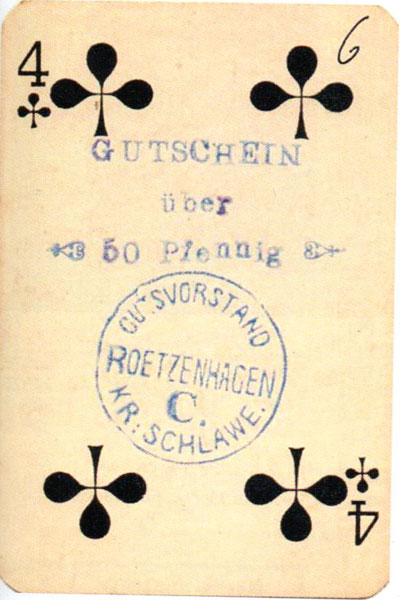
Germany
in Germany, spielkarten notgeld issued between 1914 & 1923 include the towns of Bretleben, Leipzig, Lopischewo, Marienwerder, Roetzenhagen and Stralsund.
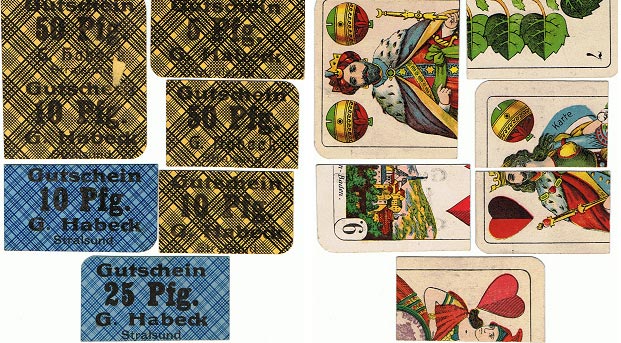

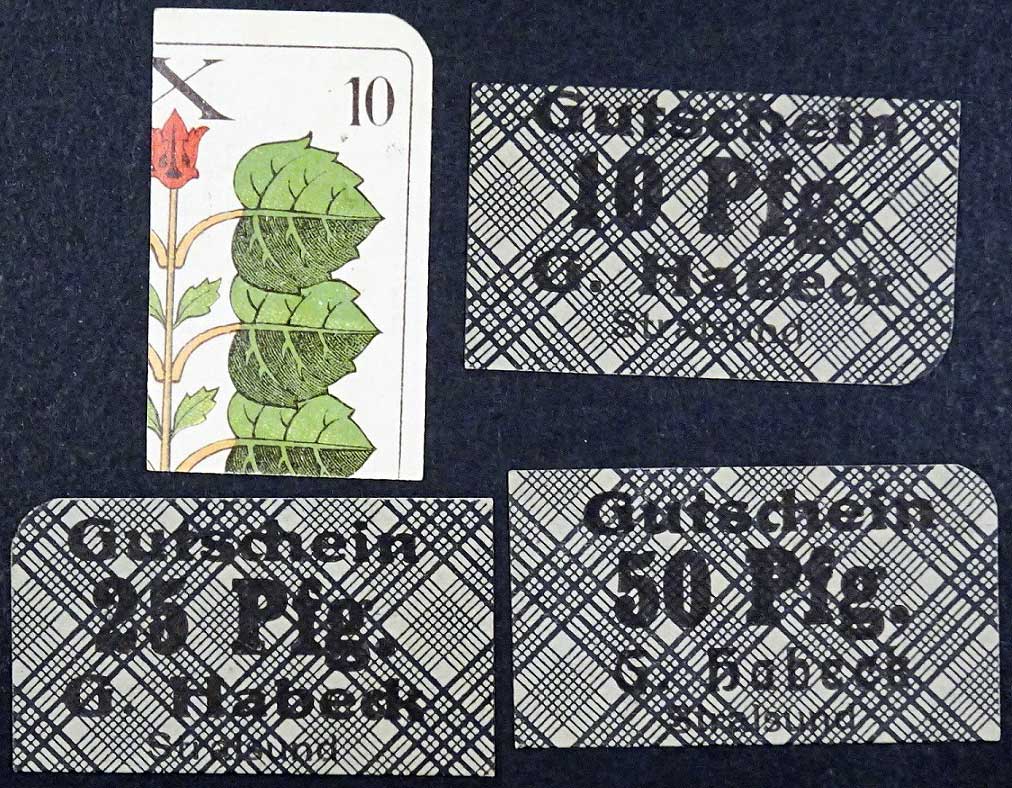
Above: these scarce serienscheine pieces were issued by Gustav Habeck from Stralsund, printed on the backs of playing cards, c.1921. They must have set up the printing plate, printed the money onto the playing cards and then cut them into seperate pieces. The pieces are different sizes, so the cutting was probably performed manually, possibly using a guillotine.
Austria
In Austria the towns of Steyregg and Reichental issued spielkarten notgeld made of playing cards in around 1920-1921. Others may also exist. Steyregg pieces had face values of either 10, 20, 30, 40, 50, 60, 80 or 90 heller. They were issued in several different colours with attractive woodcut illustrations.
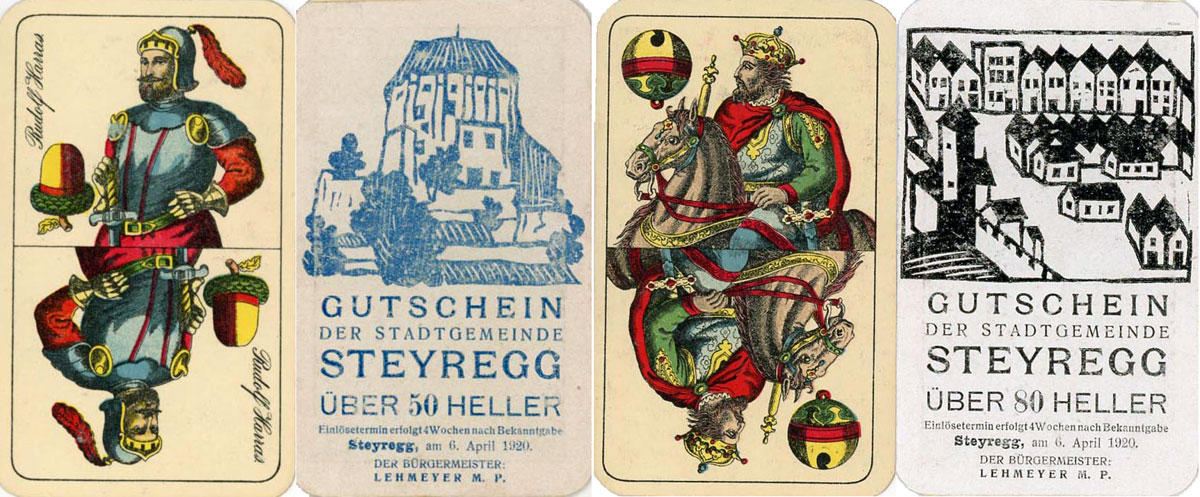
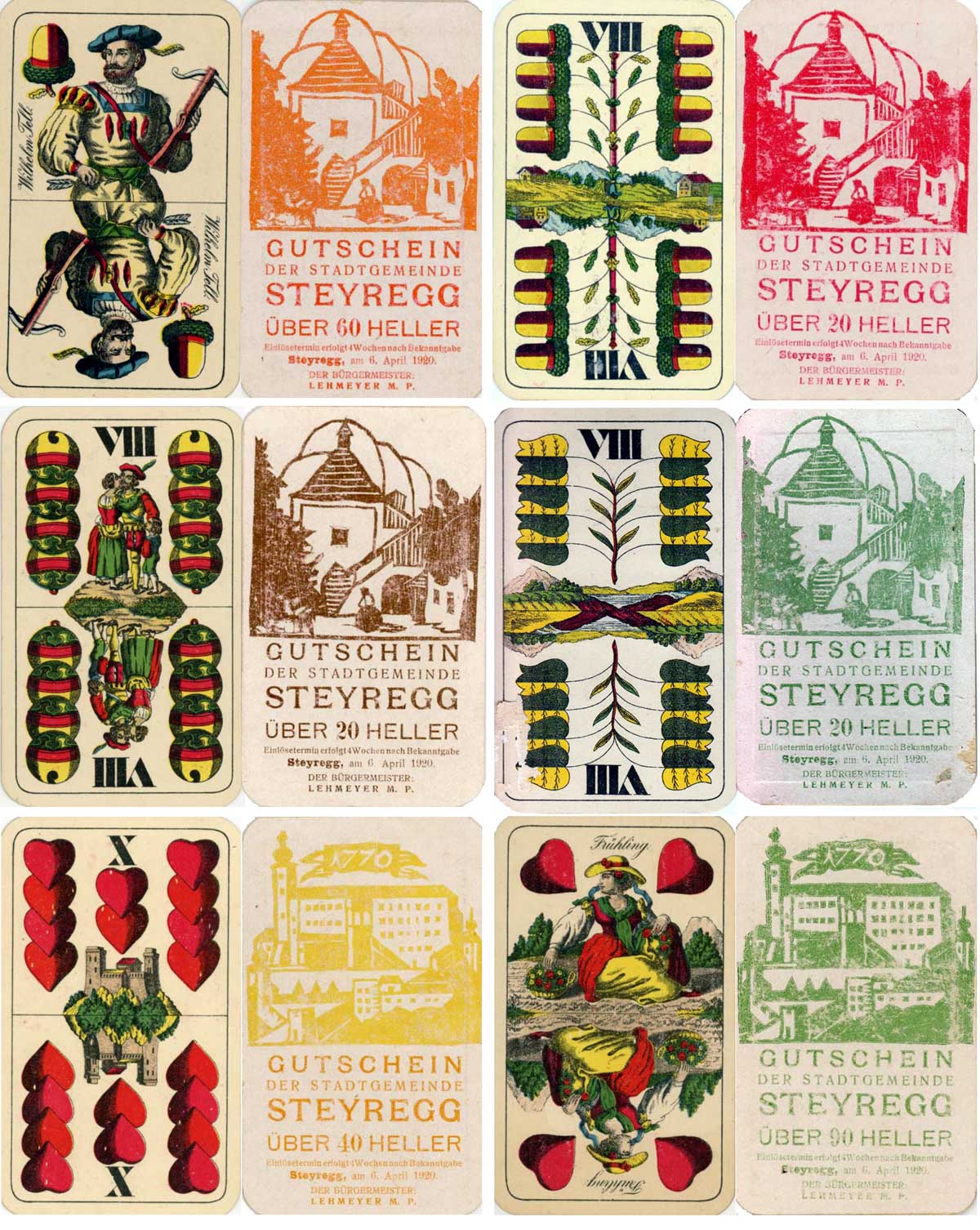
Above: spielkarten notgeld from Steyregg, c.1920-21.
The notgeld playing card pieces of Reichental were a little different. They had a stampmark on them and an 'auflage' (issue number). Face values were for either 10, 20, 30 or 50 heller. All card suits were represented, with hearts being stamped with the 50 heller value, diamonds with 30, spades with 20 and clubs with the 10 heller value.
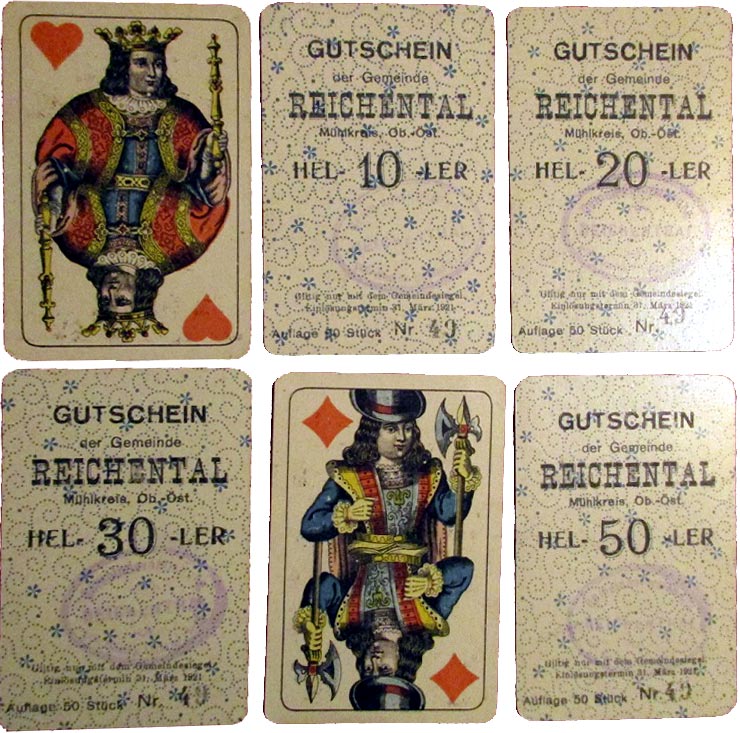
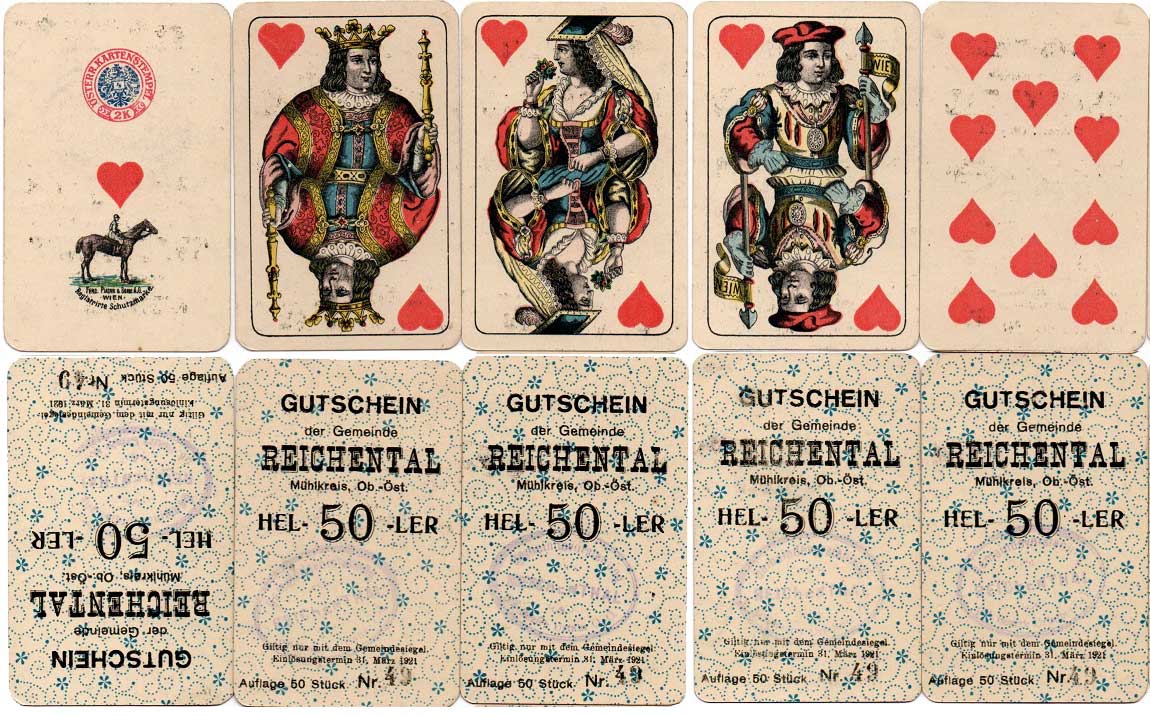
Above: Austrian spielkarten notgeld dating from 1920/21 issued in Reichental, printed onto cards made by Ferd Piatnik & Son. Instead of the face values being in German marks or pfennigs, the Austrian pieces have face values in heller or krone. The Reichental spielkarten pieces had an issue (auflage) of just 50 and these pieces come from set no.49.
Poland
The notgeld issues of 1914 tend to be plainer looking than those issued after WWI. In 1914 there was a real 'necessity' for small change money. The later issues also met a need in the collecting market!
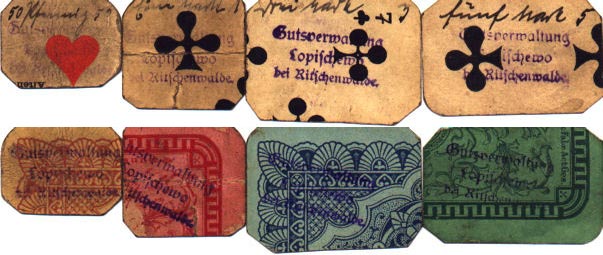
Above: ‘Gutsverwaltung’ notes were issued in Lopischewo (Polish - Lopiszewo) with no written date, although the date is known to be 8th August 1914. These ‘spielkarten’ pieces (made from playing cards) are extremely rare due to the very small numbers that were actually issued. They made 162 (81 marks worth) of the 50pf piece, 327 of the 1m piece, 164 (492 marks worth) of the 3m piece and only 99 (495 marks worth) of the 5m piece! The 50pf pieces are brown, the 1m pieces red, the 3m pieces blue and the 5m pieces green. They were all printed on either 'Hearts', 'Diamonds', 'Spades' or 'Clubs' ('Herz', 'Kreuz', 'Pik', 'Karo') - so there are 16 different pieces in total to collect. It is not known how many exist today.
CREDITS & REFERENCES
Thanks to Tony Gibbs-Murray for providing the inspiration for this page.
For further info about these pieces please visit notgeld.com►
General Secretariat of the National Bank of Belgium • Playing with money►

By Simon Wintle
Member since February 01, 1996
I am the founder of The World of Playing Cards (est. 1996), a website dedicated to the history, artistry and cultural significance of playing cards and tarot. Over the years I have researched various areas of the subject, acquired and traded collections and contributed as a committee member of the IPCS and graphics editor of The Playing-Card journal. Having lived in Chile, England, Wales, and now Spain, these experiences have shaped my work and passion for playing cards. Amongst my achievements is producing a limited-edition replica of a 17th-century English pack using woodblocks and stencils—a labour of love. Today, the World of Playing Cards is a global collaborative project, with my son Adam serving as the technical driving force behind its development. His innovative efforts have helped shape the site into the thriving hub it is today. You are warmly invited to become a contributor and share your enthusiasm.
Related Articles

Luditz Pattern by Georg Geiselreiter
The discovery of 2024 changes the current state of knowledge of the history of this pattern.

Caisse Mutuelle d'Assurance et de Prevoyance
Insurance propaganda pack for Caisse Mutuelle d'Assurance et de Prevoyance with humorous artwork by ...

CARD-AB Miltenberg
Illustrations by Rita Stern depicting notable landmarks and scenes from the town of Miltenberg in Ge...

Copechat Paramount Sorting System
Preserving the past: a specimen deck showcasing edge-notched cards and their ingenious sorting syste...

New Altenburg Skat cards – German DDR Pattern
Authentic Altenburger Skat cards with German suits (Acorns, Hearts, Leaves, Bells).

Jeu Révolutionnaire
Court cards and aces from a French Revolutionary pack by Pinaut, Paris, c.1794.

German Travel Cards
A travel-themed educational deck helping American tourists visiting Germany.

Polish Kings and Queens – red deck
Polish kings and queens plus the court jester, illustrated in a distinctive style inspired by histor...

French Revolutionary cards by Pinaut
Seven cards from a French Revolutionary pack by Pinaut featuring characters from classical antiquity...

Briefmarken-Quartett
Quartet game featuring postage stamps from the Zones of Occupation in post-WWII Germany.

Ukraine playing cards
Historical figures from Ukraine’s past in a familiar Piatnik style.

MITSCHKAtzen
Clever cat designs by the Austrian artist and illustrator Willi Mitschka.

IG Chemie Papier Keramik
Promotional pack designed by Karl-Heinz Schroers for a German trade union with comical bears on the ...

Tarock Cards by NIL Spielkartenfabrik
A deck of tarock cards from the eastern end of the ending Austro-Hungarian Empire.

Whist by Ditha Moser
Ditha Moser created this minimalist Whist deck in 1905, in the style of the Vienna Secession art mov...

Jeu Numismatique
European coins of all periods replace the traditional courts and pips.
Most Popular
Our top articles from the past 28 days




